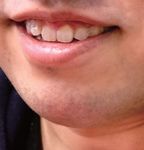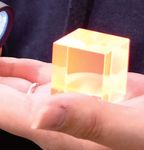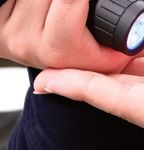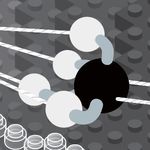FINDING CHEMICAL REACTIONS - THE - WPI-ICREDD
←
→
Page content transcription
If your browser does not render page correctly, please read the page content below
A chemical
reaction is a rearrange-
ment of building blocks,
much like when playing with
Finding
Chemical
toy bricks. Here, we have one
atom of carbon (C ) and four
atoms of hydrogen (H) combined
into the molecule methane
(CH4), as well as two times two
atoms of oxygen (O) Let’s see
Reactions
combined into oxygen what we get
gas (O2). when we
rearrange
them!
T
TAR
S Which paths
do molecules
Like sledging take?
To rearrange down a hill, chemical
atoms into different reactions proceed
molecules, bonds between naturally from molecules
atoms need to be broken with higher energy levels to
first. This requires energy, and ones with lower energy
so every chemical reaction has levels. Note that the
to overcome a barrier. The starting compounds are
stronger the bond, the higher up than the
higher the barrier, and so The starting
end products!
the more difficult the compounds can also be
reaction is. rearranged into in one
molecule of formaldehyde
(CH2O), one molecule of water
(H2O) and one molecule of
oxygen gas (O2). This almost
never happens naturally, but by
carefully controlling the
reaction conditions, this can
be made the main
Most atoms will outcome.
not stay disconnected
and will almost
immediately react with each
other to form molecules.
Therefore, the disconnected
state has the highest energy.
This is the barrier that
needs to be overcome
for a reaction to
happen.
Chemical reactions are
everywhere. Whenever matter
is transformed from one form to
Our reaction
another, a chemical reaction is the cause, burned the methane
for example when we breathe, cook, or when and resulted in one
we make drugs or materials. At ICReDD, we are molecule of carbon dioxide
(CO2) and two molecules of
developing a new way of finding entirely new water (H2O). Note that the end
chemical reactions to make making everything products have properties very
different from the starting
possible. So, what is a chemical reaction? compounds, but are
made up of the same
A L
atoms!
G OLevel Rearrangements Level Activation Energy Activation
1 2
Quiz
All things are made of atoms. There are To explain why some chemical reactions happen almost spontaneously while
a limited number of different atoms, others don’t, we assign a property to each molecule that we call “chemical
but they can bond with each other in energy”. A chemical reaction proceeds naturally if it transforms a molecule of
infinitely many ways. The resulting higher energy to one of lower
structures, called molecules, energy, whereas energy has to be
have properties that put into a reaction to proceed
depend on the arrangement from molecules of lower to higher
of the atoms they are made energy. But before they can
of. A chemical reaction is a happen, all chemical reactions What is the oldest chemical
rearrangement of atoms first need a little extra energy, reaction used by humans?
through forming or because the chemical bonds Send us your answer.
braking the bonds need to be broken before they
H: an atom
between them, giving can be rearranged. The crucial
rise to molecules point of all chemical engineering
with properties very is how to transfer the right Challenge
different from what amount of energy to the right
we started with. place in a molecule so that
specific bonds can be broken and
C: an atom formed.
CH₄: a molecule
Level Breaking Bonds Level Potential Energy Surface
3 4 Every little change of
the state of an electron
can be assigned an
The right placement of the right energy. Therefore, all
amount of energy is so crucial rearrangements of Arrange the things on your
because the bonds between electrons are chemical desk to make something. Try
atoms are maintained by reactions. And if we can to combine the same objects
electrons that are held in place calculate all energy into two or three different
by a balance of attraction to the levels of all electronic things. What did you make?
atoms’ nuclei and repulsion by rearrangements, it
other electrons. If atoms need should be possible to
to be rearranged, the repulsion know exactly how
between specific electrons much energy is needed
needs to be overcome. Only where to make every
chemical reaction Share your answer
then can chemical reactions be on social media!
realized purposefully. possible—and to produce
everything. This is the dream #ReactWithUs
of ICReDD. @ICReDDconnectNEWS
New Researchers
IDE Yuki TAKANO Hideaki TANIKAWA Satoshi PANG Yadong HASEGAWA Jun-ya
Rapid evaluation of Development of new Development of Development of new Catalysis Theory and
molecular interactions reactions by AFIR biomaterials for neural reactions using mechano- Catalysis Principle
using image diagnosis regeneration chemistry (ICReDD research
collaborator)
Selected Publications
(out of 14 papers from April to June)
Discovery of a Synthesis Method for a Theoretical and Experimental Studies on Fabrication of Bioinspired Hydrogels: Supramolecular Conformational Control
Difluoroglycine Derivative Based on a Path the Near-Infrared Photoreaction Mecha- Challenges and Opportunities of Aliphatic Oligoketones by Rotaxane
Generated by Quantum Chemical Calcula- nism of a Silicon Phthalocyanine Photoim- (H Fan, JP Gong) Formation
tions munotherapy Dye: Photoinduced Hydrolysis (T Yoneda, Y Inokuma)
DOI: 10.1021/acs.macromol.0c00238
(T Mita, Y Harabuchi, S Maeda) by Radical Anion Generation
DOI: 10.1021/acs.orglett.0c01010
(M Kobayashi, T Taketsugu)
DOI: 10.1039/D0SC02089C
DOI: 10.1002/cplu.202000338
Symposia Awards Outreach React With Us!
To stay up to date
・1st Chem-Station Virtual Symposium: ・Commendation for Science and ・Social media flyer “ICReDD Word with what’s happening at ICReDD,
“Advanced Organic Chemistry” (H Ito) Technology by MEXT Reactor” follow us on our social media channels:
( Y Nagata, T Seki) @ICReDDconnect
・3rd Chem-Station Virtual Symposium: ・Educational resource “Periodic Pen
“Young chemists talk about their ・Ube Industries Foundation Prize Stand”
experiences abroad” (N Tsuji) ( T Mita)Researcher Profile
Yu ic h i
K I T A G AWA
This is Yuichi Kitagawa.
He works on
Europium complexes that
can emit very bright red light
when illuminated with
UV or blue light.
Short biography
Specially Appointed Lecturer at ICReDD
and Faculty of Engineering, Hokkaido
University
After his Ph.D. from the University of
Tokyo in 2013, a JSPS Research Fellow at
Ritsumeikan University. From May 2014,
a Specially Appointed Assistant Professor
at the Faculty of Engineering, Hokkaido
University. Current position since April
2019. He specializes in photochemistry.About ICReDD
The development of new chemical reactions is intrinsically entangled
with the prosperity of humanity and the preservation of the environment. A
recent example of such transformative chemical reactions with profound
impact is cross-coupling reactions, the discovery of which was awarded
with the 2010 Nobel Prize in Chemistry. These reactions are used to
produce approximately 20% of all medicinal reagents, and almost all liquid
crystalline and organic electroluminescent materials. The industrial use of
these chemical reactions contributes ~60 trillion yen per annum to the
global economy. The development of new chemical reactions thus signifi-
cantly affects the evolution of society.
ICReDD is the Institute for Chemical Reaction Design and Discovery, a
WPI center at Hokkaido University where researchers from different
disciplines combine their strengths to take full control over chemical
reactions. The institute was born out of the realization that the purposeful
design of chemical reactions requires cross-sectional collaborations at
every step. Working on such a fundamental natural process, quan-
tum-chemical computations, information technology, modern experimen-
tal techniques, and the development of advanced materials can no longer
be separate fields if we want to achieve significant breakthroughs. Rather,
they have to become part of a diverse toolbox for truly integrated
research.
The Catalyst is inspired by catalysts used in chemistry to bring molecules
together, to reduce reaction barriers, and to activate molecules—to make reactions
happen faster. In this spirit, this poster series should enable its readers to make the
connection between chemical reactions and the wellbeing of our society, and to look at
the world in a new way, seeing how chemical reactions and chemistry shape the world
around them. And if we can take this opportunity to introduce ourselves, too, this may
also catalyze new friendships and opportunities. #ReactWithUs
Published in August 2020
Published by the Institute for Chemical Reaction Design and Discovery (WPI-ICReDD)
Hokkaido University
North 21, West 10, Kita Ward, Sapporo, Hokkaido, 001-0021 Japan
Telephone: + 81-11-706 -9646 (Public Relations)
Email address: public_relations@icredd.hokudai.ac.jp
https://www.icredd.hokudai.ac.jp/
Social media: @ICReDDconnectYou can also read



























































